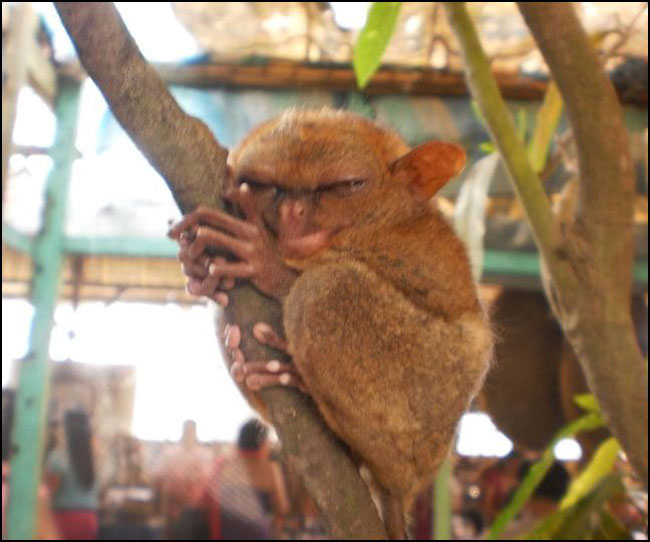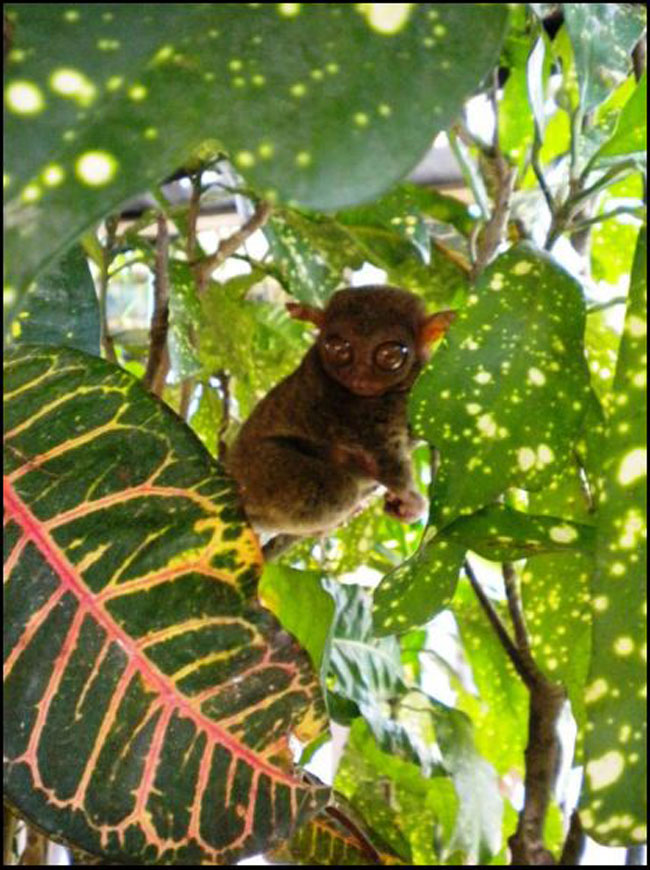- How big is the Philippine Tarsier?
- What part of the Tarsier's body is being used to balance itself (like a tripod)?
- What is being used by tarsiers to communicate?
- How long will Tarsiers live in the wilds?
- If a tarsier is placed in captivity, what sort of affliction does it suffer?
Philippine tarsier is believed to have been around for about 45 million years. It is one of the oldest land species existing in the country.

Photo of the tarsier holding the branch and looking at the girl
Distinguishing Characteristics of a Tarsier
The eyes of a tarsier are huge and are directed forward with a staring look. A tarsier cannot glance from the corner of its eyes, and needs to turn its head around (stretching it as far as 180 to nearly 360 degrees) in order to see an object. During daytime or when exposed to bright light, the pupils of its eyes become so contracted that they appear as dots. During night time, the pupils expand or dilate. Tarsiers are nocturnal creatures. They are alert at night when hunting for their prey.
Another distinguishing feature of a tarsier is its large membranous and papery ears which look like those of bats. Their ears can easily be twisted, crinkled or moved in the opposite direction especially when tarsiers get excited.
Tarsiers have thin, rough furs that normally range from gray to dark brown. Their tails, which are measured to be about twice their body length, are usually utilized to balance themselves like a tripod.

Picture of a Tarsier sleeping
Life Span of a Tarsier
In the wilds, a tarsier is expected to live up to 24 years. In captivity, a tarsier lives for a little more than 12 years. In some instances, many tarsiers seized from the wilds and placed in captivity survive for only 2-5 years. Some tarsiers placed in enclosed areas were reported to have committed suicide by smashing their heads through hard objects. It has been observed that tarsiers held in captivity can suffer from psychological trauma.

Picture of a Tarsier with round big eyes
How do Tarsiers communicate?
Tarsiers communicate with each other using loud calls, characterized by a loud piercing single note which is similar to the sound of sweet bird-like twill. When tarsiers come close to each other or come in groups, they produce a chirping locust-like sound.
Infant tarsiers make distress calls when separated from their mothers.
Tarsier population has been diminishing due to rapid destruction of their forest habitats.
Tarsiers are mostly found in Samar, Leyte, Bohol, and in some parts of Mindanao (Philippines).
I hope you learned something new about our famous Philippine tarsiers that we should be proud of. - https://www.affordablecebu.com/